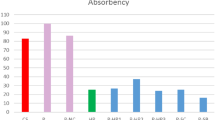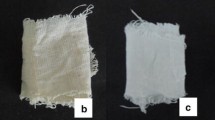Abstract
In the present study, fabrics constructed from cotton, regenerated bamboo, poly(lactic acid), and soy protein fibers were scoured with pectinase enzymes, bleached with different bleaching processes using peracetic acid (PAA), and conventionally bleached with hydrogen peroxide (HP). The enzymatic scouring and bleaching with PAA have been chosen in order to minimize fiber damage and to perform the processes in more benign conditions. PAA was added to the bleaching bath in the form of a commercial solution or it was produced in situ in the presence of HP with the addition of a bleach activator, tetraacetylethylenediamine (TAED), or arylesterase enzymes. The conventional process was performed at 90 °C in highly alkaline pH media, and the bleaching processes with PAA were performed at 65 °C in neutral to slightly alkaline pH media. The results revealed that after the enzymatic scouring, the hydrophilicity of the fabrics is adequate. Compared with the cotton fibers, the regenerated bamboo and especially the poly(lactic) acid and soy protein fibers are significantly damaged during conventional HP bleaching. By contrast, bleaching with PAA revealed a strong whitening ability that is comparable to that of conventional bleaching with HP but with substantially reduced fiber damage.
Similar content being viewed by others
References
N. Erdumlu and B. Ozipek, Fibres Text. East. Eur., 16, 43 (2008).
W. Yueping, Text. Res. J., 80, 334 (2010).
B. Lipp-Symonowicz, S. Sztajnowski, and D. Wojciechowska, Fibres Text. East. Eur., 19, 18 (2011).
J. R. Dorgan, H. Lehermeier, and M. Mang, J. Polym. Environ., 8, 1 (2008).
J. S. Dugan, Int. Nonwovens J., 10, 29 (2001).
D. W. Farrington, J. Lunt, S. Davies, and R. S. Blackburn in “Biodegradable and Sustainable Fibres” (R. R. Blackburn, Ed.), pp.89–440, Woodhead Publishing, Cambrige England, 2005.
J. Lunt and A. Shafer, J. Ind. Text., 29, 191 (2005).
C. W. Lou, C. H. Yao, Y. S. Chen, T. C. Hsieh, J. H. Lin, and W. H. Hsing, Text. Res. J., 78, 958 (2008).
T. Rijavec and Ž. Zupin in “Recent Trends for Enhancing the Diversity and Quality of Soybean Products” (D. Krezhova Ed.), pp.01–522, InTech, Rijeka, 2011.
S. Cimilli, B. Nergis, C. Candan, and M. Ozdemir, Text. Res. J., 80, 948 (2010).
M. M. Brooks in “Biodegradable and Sustainable Fibres” (R. S. Blackburn Ed.), pp.98–440, Woodhead Publishing Limited in Association with the Textile Institute Abington Hall, Abington, Cambridge, 2005.
L. Yi-you, Fibres Text. East. Eur., 12, 8 (2004).
E. S. Abdel-Halim and S. S. Al-Deyab, Carbohydr. Polym., 86, 988 (2011).
A. S. Aly, A. B. Moustafa, and A. Hebeish, J. Cleaner Prod., 12, 697 (2004).
P. Preša and P. Forte Tavcer, Text. Res. J., 79, 76 (2009).
P. Križman, F. Kovac, and P. Forte Tavcer, Color. Technol., 121, 304 (2005).
J. Y. Cai, D. J. Evans, and S. M. Smith, AATCC Rev., 1, 31 (2001).
K. R. Jegannathan and P. H. Nielsen, J. Clean. Prod., 42, 234 (2013).
N. Špicka and P. Forte Tavcer, Mater. Technol., 47, 409 (2013).
N. Špicka and P. Forte Tavcer, Text. Res. J., 85, 1497 (2015).
K. E. Perepelkin, Fibre Chem., 34, 85 (2002).
I. N. Phatthalung, P. Sae-be, J. Suesat, P. Suwanruji, and N. Soonsinpai, Int. J. Biosci. Biochem. Bioinform., 2, 179 (2012).
J. F. Moulder, W. F. Stickle, P. E. Sobol, and K. D. Bomben, “Handbook of X-ray Photoelectron Spectroscopy” (E. Prairie Ed.), Physical Electronics Inc., Minnesota, 1995.
D. L. Massart, B. G. M. Vandeginste, L. M. C. Buydens, S. De Jong, P. J. Lewi, and J. Smeyers-Verbeke, “Handbook of Chemometrics and Qualimetrics: Part A”, pp.20–535, Elsevier Science B.V., Amsterdam, 1997.
C. Chung, M. Lee, and E. K. Choe, Carbohydr. Polym., 58, 417 (2004).
Y. Sun, L. Lin, H. Deng, J. Li, B. He, R. Sun, and P. Ouyang, BioResources, 3, 297 (2008).
R. Mitchell, C. M. Carr, M. Parfitt, J. C. Vickerman, and C. Jones, Cellulose, 12, 629 (2005).
T. Topalovic, V. A. Nierstransz, L. Bautista, D. Jocic, A. Navarro, and M. M. C. G. Waroeskerken, Cellulose, 14, 385 (2007).
Author information
Authors and Affiliations
Corresponding author
Rights and permissions
About this article
Cite this article
Špička, N., Zupin, Ž., Kovač, J. et al. Enzymatic scouring and low-temperature bleaching of fabrics constructed from cotton, regenerated bamboo, poly(lactic acid), and soy protein fibers. Fibers Polym 16, 1723–1733 (2015). https://doi.org/10.1007/s12221-015-5140-1
Received:
Revised:
Accepted:
Published:
Issue Date:
DOI: https://doi.org/10.1007/s12221-015-5140-1




